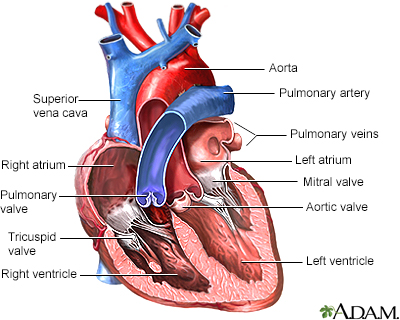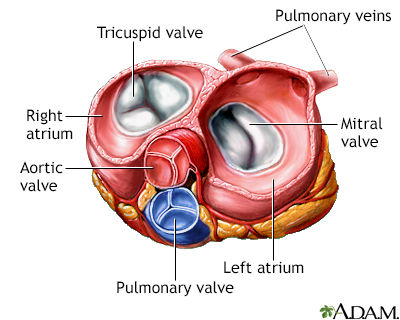Left heart ventricular angiography
Angiography - left heart; Left ventriculography
Left heart ventricular angiography is a procedure to look at the left-sided heart chambers and the function of the left-sided valves. It is sometimes combined with coronary angiography.
Images


I Would Like to Learn About:
How the Test is Performed
Before the test, you will be given medicine to help you relax. You will be awake and able to follow instructions during the test.
An intravenous line is placed in your arm. A cardiologist cleans and numbs an area on your arm or groin. Then the doctor makes a small cut in the area, and inserts a thin flexible tube (catheter) into an artery. Using x-rays as a guide, they carefully move the thin tube (catheter) into your heart.
When the tube is in place, dye is injected through it. The dye flows through the blood vessels, making them easier to see. X-rays are taken as the dye moves through the blood vessels. These x-ray pictures create a "movie" of the left ventricle as it contracts rhythmically.
The procedure will usually last less than one hour, but may take be considerably longer, especially if combined with other procedures.
How to Prepare for the Test
You will be told not to eat or drink for 6 to 8 hours before the test. The procedure takes place in the hospital or a specialized procedure unit. Some people may need to stay in the hospital the night before the test.
Your cardiologist will explain the procedure and its risks. You must sign a consent form for the procedure.
How the Test will Feel
You will feel a sting and burn when the local anesthetic is injected. You may feel pressure when the catheter is inserted. Occasionally, a flushing sensation or a feeling that you need to urinate occurs when the dye is injected.
Why the Test is Performed
Left heart angiography is performed to assess the blood flow through the left side of the heart.
Normal Results
A normal result shows normal blood flow through the left side of the heart. Blood volumes and pressures are also normal.
What Abnormal Results Mean
Abnormal results may be due to:
- A hole in the heart (ventricular septal defect) or other abnormal connections (congenital heart disease)
- Abnormalities of the left heart valves
- An aneurysm of the heart wall
- Areas of the heart that are not contracting normally
- Blood flow problems on the left side of the heart
- Heart-related blockages
- Weakened pumping function of the left ventricle
Coronary angiography may be needed when blockage of the coronary arteries or other coronary abnormalities is suspected.
Risks
Risks associated with this procedure include:
- Abnormal heartbeats (arrhythmias)
- Allergic reaction to dye or sedating medicines
- Artery or vein damage
- Cardiac tamponade
- Embolism from blood clots at the tip of the catheter
- Heart failure due to the volume of the dye
- Infection
- Kidney failure from the dye
- Low blood pressure
- Heart attack
- Hemorrhage
- Stroke
Considerations
Right heart catheterization may be combined with this procedure.
Left heart ventricular angiography has some risk because it is an invasive procedure. Other imaging techniques may carry less risk, such as:
- CT scans
- Echocardiography
- Magnetic resonance imaging (MRI) of the heart
- Radionuclide ventriculography
Your cardiologist may decide to perform one of these procedures instead of left heart ventricular angiography.
References
Kern MJ, Seto AH, Herrmann J. Invasive hemodynamic diagnosis of cardiac disease. In: Libby P, Bonow RO, Mann DL, Tomaselli GF, Bhatt DL, Solomon SD, eds. Braunwald's Heart Disease: A Textbook of Cardiovascular Medicine. 12th ed. Philadelphia, PA: Elsevier; 2022:chap 22.
Valente AM, Dorfman AL, Babu-Narayan SV, Krieger EV. Congenital heart disease in the adolescent and adult. In: Libby P, Bonow RO, Mann DL, Tomaselli GF, Bhatt DL, Solomon SD, eds. Braunwald's Heart Disease: A Textbook of Cardiovascular Medicine. 12th ed. Philadelphia, PA: Elsevier; 2022:chap 82.
Virani SS, Newby LK, Arnold SV, et al. 2023 AHA/ACC/ACCP/ASPC/NLA/PCNA guideline for the management of patients with chronic coronary disease: A report of the American Heart Association/American College of Cardiology Joint Committee on Clinical Practice Guidelines. J Am Coll Cardiol. 2023;82(9):833-955. PMID: 37471501 www.ncbi.nlm.nih.gov/pubmed/37471501/.
BACK TO TOPReview Date: 10/15/2024
Reviewed By: Michael A. Chen, MD, PhD, Associate Professor of Medicine, Division of Cardiology, Harborview Medical Center, University of Washington Medical School, Seattle, WA. Also reviewed by David C. Dugdale, MD, Medical Director, Brenda Conaway, Editorial Director, and the A.D.A.M. Editorial team.

Health Content Provider
06/01/2025
|
A.D.A.M., Inc. is accredited by URAC, for Health Content Provider (www.urac.org). URAC's accreditation program is an independent audit to verify that A.D.A.M. follows rigorous standards of quality and accountability. A.D.A.M. is among the first to achieve this important distinction for online health information and services. Learn more about A.D.A.M.'s editorial policy, editorial process and privacy policy. A.D.A.M. is also a founding member of Hi-Ethics. This site complied with the HONcode standard for trustworthy health information from 1995 to 2022, after which HON (Health On the Net, a not-for-profit organization that promoted transparent and reliable health information online) was discontinued. |
The information provided herein should not be used during any medical emergency or for the diagnosis or treatment of any medical condition. A licensed medical professional should be consulted for diagnosis and treatment of any and all medical conditions. Links to other sites are provided for information only -- they do not constitute endorsements of those other sites. © 1997- 2025 A.D.A.M., a business unit of Ebix, Inc. Any duplication or distribution of the information contained herein is strictly prohibited.
